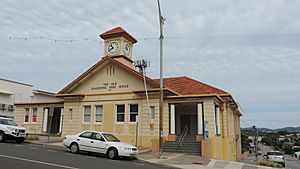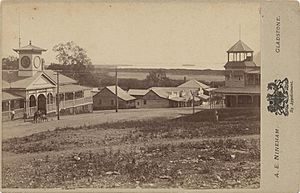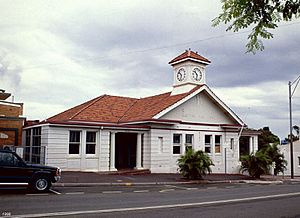Gladstone Post Office facts for kids
Quick facts for kids Gladstone Post Office |
|
|---|---|

Former Gladstone Post Office, 2014
|
|
| Location | 33 Goondoon Street, Gladstone, Gladstone Region, Queensland, Australia |
| Design period | 1919 - 1930s (interwar period) |
| Built | 1932 |
| Architectural style(s) | Classicism |
| Official name: Gladstone Post Office (former) | |
| Type | state heritage (built) |
| Designated | 7 May 1998 |
| Reference no. | 601331 |
| Significant period | 1930s (fabric) 1930s-1990s (historical, social) |
| Significant components | tower - clock |
| Builders | Relief workers |
| Lua error in Module:Location_map at line 420: attempt to index field 'wikibase' (a nil value). | |
The Gladstone Post Office is an old building in Gladstone, Queensland, Australia. It used to be a post office where people sent letters and parcels. It was built in 1932 by workers who needed jobs during a tough time called the Great Depression. This building is important because it's part of Queensland's history and has a special look. It was added to the Queensland Heritage Register in 1998, which means it's protected for its historical value.
Contents
A Look Back: The Post Office Story
The former Gladstone Post Office was built in 1932. It was designed specifically to be a post office. It replaced older post and telegraph offices that were on the same spot. This building was at least the third post office built in Gladstone.
It was designed by the Federal Director-General of Works in Canberra. This building was one of several important public buildings built in Gladstone during the years between World War I and World War II. These projects helped create jobs. Other buildings from this time include the 1929 Commonwealth Bank Building and the 1934 Town Council Chambers. These buildings helped shape Gladstone's look in the 20th century. They are still important landmarks today.
Early Postal Services in Gladstone
Gladstone was started by the New South Wales colonial government in 1854. The town's first post office opened on July 1, 1854. It was located at the corner of Goondoon and Yarroon Streets.
In the late 1850s and early 1860s, postal services began connecting Gladstone to other towns. These included Gayndah, Maryborough, and Rockhampton. Services also reached the Calliope Goldfields by 1864. By 1860, mail from Brisbane arrived by steamer every two weeks. This became a weekly service by 1871. On November 28, 1864, the overland telegraph service reached Gladstone. This linked the town with Brisbane, Rockhampton, and inland areas.
In 1869, a strong brick building was put up at the corner of Lord and Goondoon Streets. It was meant to be a Post and Telegraph Office and a Customs House. It also had homes for the postmaster and telegraph master. For a short time, these services shared the building. Later, it became just the Gladstone Customs House.
The post and telegraph departments then moved to temporary places. A large timber building was built for them in 1877-1878. This building was on Goondoon Street, at the intersection with Yarroon Street. This was a well-known and central spot. A telephone line opened at the Gladstone Post & Telegraph Offices on September 20, 1910. The main telephone exchange was built in 1911.
In 1912, most of Queensland's Post and Telegraph Department buildings, including Gladstone's, were given to the Commonwealth Government.
A New Building for a New Era
By the late 1920s, the old Gladstone Post and Telegraph Offices were looking quite worn out. This was a bit embarrassing for the local community. Government inspectors suggested in 1925 and 1927 that it wasn't worth spending a lot of money on repairs. They recommended building a new brick or concrete structure instead.
However, the Postmaster-General's Department didn't act right away. By late 1928, the condition of the post office became an issue in local elections. In 1929, Frank Forde, a federal Member of Parliament for the Capricornia area, pushed for a new post office.
Finally, in 1930-1931, money was set aside for a new brick building with a tiled roof. It was expected to cost about £5,540. But by the end of 1930, the world was in a deep economic crisis called the Great Depression. Australia, which relied on farming, was hit hard. So, the plan for the new post office was put on hold.
The depression got worse. In November 1931, the Federal Works Director for Queensland, James Orwin, suggested a solution. He recommended that new post offices in Gladstone and other towns be built using special funding for "relief schemes." These schemes hired people who were out of work, paying them for their labor. This idea was accepted. Work on the Gladstone project started almost immediately. By late January 1932, a foreman was hired, and half of the old 1870s building was sold to be moved.
The new post office was built on the same land as the old one. To make space, the post office part and clock tower of the 1870s building were taken down first. The post office then temporarily shared space with the telegraph office. Once the new building was finished, the old Telegraph Offices were also removed.
Design and Features
The new post office was a single-story building made of brick with a smooth, rendered finish. It had a tiled roof. It featured two entrance porches that were arranged in a balanced way on the front. Unlike the earlier Gladstone Post and Telegraph Offices, this new building did not include living areas for the postmaster or telegraph master.
Only seven of this "twin porch" style of brick post office were built in Queensland between 1923 and 1932. However, 25 timber post offices with a similar design were built during this time. These brick post offices show how Queensland moved from building with timber to using more brick. They also show the change from designs by the Queensland Works Department to the Commonwealth Works Department.
The Gladstone Post Office was the only one of these "twin porch" brick post offices in Queensland to have a clock tower. This shows how important Gladstone was as a regional center. The clock mechanism itself was not new. It had been used before in Maryborough and dated back to at least 1900. It was repaired and used again in the new building. In 1932, the Gladstone Town Council agreed to light up the clock faces every night until midnight.
The new post office officially opened on July 23, 1932. Members of the Gladstone Town Council, Chamber of Commerce, and Harbour Board toured the building. Everyone thanked Mr. Frank Forde, the local Member of Parliament, for helping to make the building happen.
Later Changes
In the late 1940s, a two-story brick building was added behind the post office. This was for telephone equipment. It was extended in 1965-67 and connected to the 1932 post office. Around this time, the post office building was also extended on its southern side to make room for public telephones.
By 1976, the post office had been changed several times. A large, two-story brick extension was added to the back. This meant the original back wall of the 1932 building was removed. The two public entrances were also changed. Inside, new walls were added to create more private post boxes.
By the mid-1990s, new ways of handling mail meant the building was no longer needed by Australia Post. It was sold to a private company in 1997. The inside has been changed since then to create office spaces. However, the main parts of the building that face the street are still mostly the same. The building, with its clock tower, is still a key part of the Gladstone town.
Building Description
The former Gladstone Post Office is a single-story building. It is made of brick with a smooth, rendered finish and has a terracotta-tiled hipped roof. It has a tall, noticeable clock tower and a two-story brick extension at the back. The building is on Goondoon Street, which is the main street in Gladstone. It also looks out over the harbor.
The main front of the building faces Goondoon Street. It has two porches with flat roofs on either side of a part that sticks out, called a gable. The building is designed in a stripped classical style, which means it uses simple, traditional shapes. The clock tower sits above the gabled end. It is square and has a clock face on all four sides. It is topped with a pyramidal terracotta roof. Below the clock tower, the gabled part has two pairs of sash timber windows that are arranged evenly. You can still see signs of the original name in the triangular part of the gable.
The entrances to the two porches are marked by simple columns. The northern porch is reached by steps. Modern aluminum shop fronts and doors lead into the building. The southern porch has been extended along the side of the building. This extension is also made of rendered brick, with paired sash windows and a flat metal roof. The southern porch also has aluminum shop fronts and doors.
The northern side of the building has two sets of timber sash windows that are arranged evenly. The basement level below has three timber sash windows with many small panes of glass.
Inside, the main level of the 1932 Post Office, which faces Goondoon Street, is now one large open space. The original timber floor is still there, along with some small parts of the old internal walls. The ceiling has been removed as part of the work to update the building. The back wall of the original building was taken down when the extension was built.
The two-story brick extension at the back has a flat roof. A concrete staircase leads to the lower level. This level has several small rooms and connects to the two basement rooms of the 1932 building.
Why It's Important: Heritage Listing
The former Gladstone Post Office was added to the Queensland Heritage Register on May 7, 1998. This means it is recognized as an important historical place.
- It shows how Queensland's history developed.
The former Gladstone Post Office, built in 1932, helps us understand how Gladstone grew as a major regional center. It was one of several public buildings built in Gladstone during the years between the World Wars. These projects helped create jobs during the Great Depression. This shows a positive side of how the depression affected regional Queensland.
- It has special beauty and design.
Together, these buildings helped create Gladstone's look in the 20th century. They are still important landmarks. The former Post Office is in a prominent spot and has a clock tower. Its street-facing exterior is still mostly original. It remains a key part of the Gladstone town, standing out as a landmark.
- It has a strong connection to the community.
The building has been a central part of Gladstone for many years. It served the community as a post office and is a well-known landmark. This gives it a special connection to the people of Gladstone.



